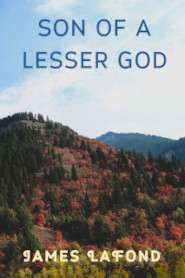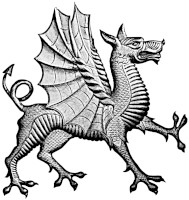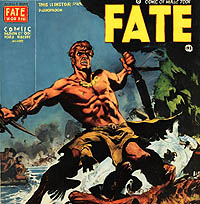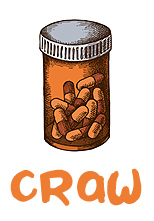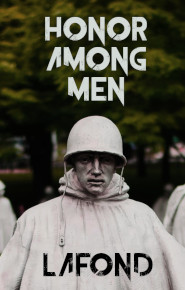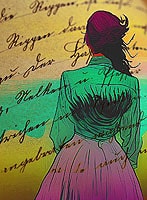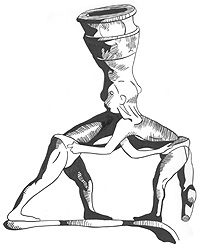First published in October 1933 in Weird Tales, reading from the 203 Del Rey collection The Coming of Conan the Cimmerian, illustrated by Mark Shultz
The Pool of the Black One shows artist Mark Shultz at his best. The color art on the jacket is the scene where Conan fights a towering black humanoid for his sexual property, Sancha, babe of babes, whose cruel master has just been butchered by the treacherous barbarian so that he might spread her dainty thighs. With such esteemed motives backing his fury, there is no doubt the barbarian will fell his foe. Never-the-less Howard still manages to evoke a horrific sense of peril which Shultz captured ever so luridly.
Interestingly enough Howard again begins this Conan story from the point of view of a captive female. This provides much narrative contrast, as a soft civilized dainty, enslaved by a cruel pirate, sees a rugged man clime up over a ship’s rail where she sunbathes in the middle of an ocean, having swam the open sea to board this ship. Howard shows a clear understanding of a woman’s oppressed lot in life under such circumstances. Sancha goes on to cut a sympathetic figure throughout the story, even managing to save Conan’s hairy ass on one occasion; not as a contemporary writer would depict her action as flying through the air with blades whirling, dismembering countless foes in her Bruce Lee inspired flight, but as a ‘team player’ using her wits and her wine colored lips to turn the tide of battle.
Howard’s imagery, from scenery to battle is purely atmospheric, evocative. In this short story he addresses the plight of women, the nature of leadership among men, the plight of the doomed, the nature of horror in the human psyche, and fury as a dynamic component in storytelling, not as the decorative rage used today to overlay subpar action.
But first, before all of this, in the first scene of the story, Howard gives it all away, tells the bare bones of his tale in one sentence. Conan stands over Sancha, dripping seawater on the deck as her cruel master, Captain Zaparovo, a true badass, questions his appearance and purpose. Conan responds that every ship could use a good sailor. Let Howard take it up:
“Zaparovo scowled, knowing the truth of that assertion. He hesitated, and in doing so, lost his ship, his command, his girl, and his life.”
As a writer that declaration at the beginning of the story takes balls. Howard does not cast the doomed captain aside though. He even writes two passages from his perspective, declares narrative sympathy with his arcane obsessions, and has him fight heroically against the dynamic giant, lethal to the bitter end. By giving away the plot that one could have guessed anyhow, the author sets out into the shadows that border the sane world using a typical pulp author’s story as his stage set, merely a ruthless platform for mankind’s petty struggles through which Conan receives yet another glimpse of the supernatural world that threatens to engulf his own reality. Throughout the series this is the consistent theme; that man is doomed—even such a doom-bringing man as Conan—to shiver before the horrific truths that underlay his mere perceptions.
This is what makes a Conan story. I have often said that the only real Conan movie was Predator, in which the earthly goal of men to do unto other men is nothing but the stage set for the entrance of man’s supernatural foes. Even as Conan is the magnet for much of the supernatural menace that Howard evokes to terrorize his cast, he is also sangfroid about it. When Conan ‘raced like the wind of death’ and slays the Black One depicted in Mark’s painting, Sancha asks if they are in hell and that is a devil. Conan responds, “Then hell needs a new devil”
I recently reviewed The Vale of Lost Women with Victoria, and she did not believe it was a complete story but the bones of a novel. That is because Howard wrote for men, not women, even as he struggled to understand the world of women through the characters in his fiction. When Conan states at the end of the story that he will return the woman he betrayed and murdered for to her homeland, to a woman, that sets the stage for an epic quest to get the female character home.
No. Conan says he’s taking you home—you’re home. No adventure necessary. You see, it is not a Conan adventure unless it is an adventure for Conan. Getting a girl home does not qualify. The essence of the Conan character is his dynamic masculinity, largely expressed by a lack of any need to tie up loose ends that no self-respecting novelist would leave twisting in the fictional wind.
In large measure this was Sancha’s great adventure. For Conan, it was just the acquisition of an exceptional piece of ass with ‘lips like wine’. For the prodding Arуan soul, investigating his ancestry along the trajectory of slaughter described by his doom-driven ancestors, Howard's death-dealing hero—more than willing to suffer the diversion of a seductress—represents the tribe-generating passion of the doomed individual, who breathes life into an heroic ethos even as he breathes his mythic last. In Pool of the Black One Howard gives the reader a prequel of The Iliad, as he casts Achilles as Conan, plucking Hades' beard as he keeps the dark night of fate at bay.
What Howard keeps alive—or, better, resurrects—in his Conan stories is the White Man's unique spirit of defiance of the cosmic order personified by Gilgamesh, Achilles, and Beowulf. Conan is all three wrapped into one, spreading Shamahat's legs, butchering Agamemnon rather than tolerating his social status, and irreverently slaughtering the hideous children of the elder gods, heedless of the fact that he will one day join them.


